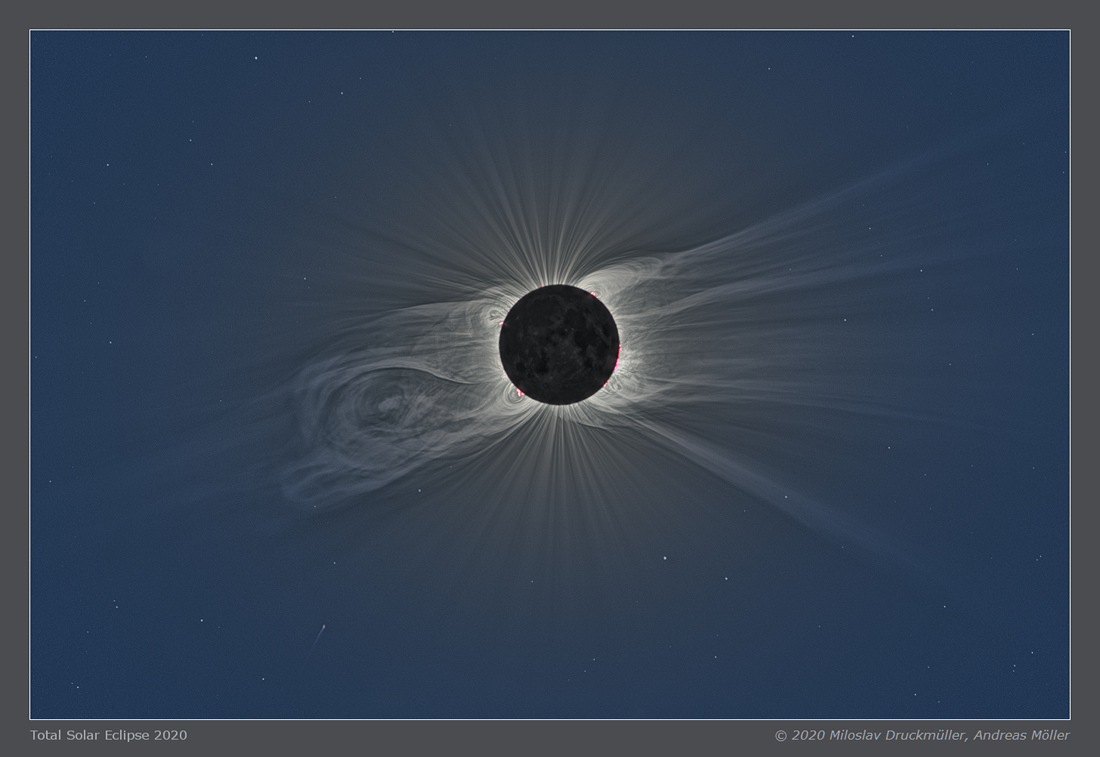2021年01月07日
Total Solar Eclipse 2020
Image Credit & Copyright: Miloslav Druckmuller, Andreas Moller, (Brno University of Technology),
Explanation: Along a narrow path crossing southern South America through Chile and Argentina, the final New Moon of 2020 moved in front of the Sun on December 14 in the year’s only total solar eclipse. Within about 2 days of perigee, the closest point in its elliptical orbit, the New Moon’s surface is faintly lit by earthshine in this dramatic composite view. The image is a processed composite of 55 calibrated exposures ranging from 1/640 to 3 seconds. Covering a large range in brightness during totality, it reveals the dim lunar surface and faint background stars, along with planet-sized prominences at the Sun’s edge, an enormous coronal mass ejection, and sweeping coronal structures normally hidden in the Sun’s glare. Look closely for an ill-fated sungrazing Kreutz family comet (C/2020 X3 SOHO) approaching from the lower left, at about the 7 o’clock position. In 2021 eclipse chasers will see an annular solar eclipse coming up on June 10. They’ll have to wait until December 4 for the only total solar eclipse in 2021 though. That eclipse will be total along a narrow path crossing the southernmost continent of Antarctica.
Tomorrow’s picture: pixels in space
2020年日全食
影像提供与版权: Miloslav Druckmuller, Andreas Moller, (Brno University of Technology),
说明: 12月14日,在南美洲智利到阿根廷的一道狭窄带上,2020年最后一轮新月掩过太阳的前方,带来2020年唯一的日全食。在这幅精采的组合影像里,离椭圆轨道最近地球的近地点2天的新月,其表面受到地照光微微照亮。而这幅影像,则组合自55张经过校正、曝光时间介于1/640至3秒的照片。影像除了呈现全食阶段大范围的亮度变化,也记录了暗淡的月表、背景恒星、太阳边缘大小与行星相当的日珥、庞大的日冕物质抛射事件、及通常受太阳炫光遮掩而不得见的流泛日冕。如仔细检视,还可见到一颗难逃灭亡命运的克罗伊泽族掠日彗星C/2020 X3 SOHO,从左下方大约7点钟的方位向内飞掠。在2021年的6月10日,追日食者可见到日环食。不过,如想见到2021年唯一的日全食,得再等到12月4日。届时可见的区域,是在南极洲的一道狭窄食带上。
明日的图片: pixels in space



